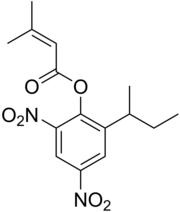 | |
| Names | |
|---|---|
| Preferred IUPAC name 2-(Butan-2-yl)-4,6-dinitrophenyl 3-methylbut-2-enoate | |
| Other names
2--4,6-dinitrophenyl 3-methylbut-2-enoate (RS)-2-(Butan-2-yl)-4,6-dinitrophenyl 3-methylbut-2-enoate (RS)-2-sec-Butyl-4,6-dinitrophenyl 3-methylbut-2-enoate Dapacryl Morocide Morrocid Acricid Endosan Ambox Dinoseb methacrylate | |
| Identifiers | |
| CAS Number | |
| 3D model (JSmol) | |
| ChEBI | |
| ChEMBL | |
| ChemSpider | |
| ECHA InfoCard | 100.006.921 |
| EC Number |
|
| KEGG | |
| PubChem CID | |
| RTECS number |
|
| UNII | |
| UN number | 2779 |
| CompTox Dashboard (EPA) | |
InChI
| |
SMILES
| |
| Properties | |
| Chemical formula | C15H18N2O6 |
| Molar mass | 322.317 g·mol |
| Density | 1.2 g/cm |
| Melting point | 66 to 67 °C (151 to 153 °F; 339 to 340 K) |
| Solubility in water | Insoluble |
| Hazards | |
| GHS labelling: | |
| Pictograms |   
|
| Signal word | Danger |
| Hazard statements | H302, H312, H360, H410 |
| Precautionary statements | P201, P202, P264, P270, P273, P280, P281, P301+P312, P302+P352, P308+P313, P312, P322, P330, P363, P391, P405, P501 |
| Except where otherwise noted, data are given for materials in their standard state (at 25 °C , 100 kPa).
| |
Binapacryl was used as a miticide and fungicide. Chemically, it is an ester derivative of dinoseb. Although binapacryl has low toxicity itself, it is readily metabolized to form dinoseb, which is highly toxic.
International trade in binapacryl is regulated by the Rotterdam Convention; it has been withdrawn as a pesticide, since products were highly toxic to mammals, fish and aquatic invertebrates.
References
- ^ Datasheet from International Programme on Chemical Safety
- Pesticide Properties DataBase: Binapacryl